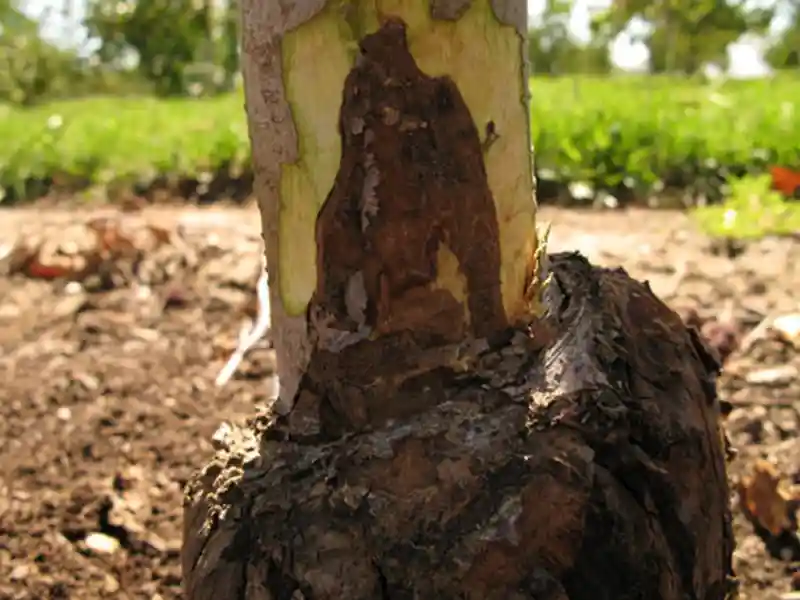How to Prevent and Treat Root Rot on Utah Trees
Root rot happens when soil stays too wet and kills tree roots. This fungal disease destroys roots from the inside out. South Salt homeowners face this problem because our clay soil drains poorly.
Your trees show yellowing leaves and weak growth when roots decay. This matters because dead roots mean dead trees. Without healthy roots, your entire landscape suffers.
We know how to stop root rot before it destroys your trees. This guide teaches you simple steps to save your plants. You’ll learn prevention tricks and treatment methods that actually work.

Root Rot Prevention Strategies
Preventing root rot starts with fixing your soil drainage right now. This problem happens when water sits around roots too long. Customers struggle with soggy soil that suffocates tree roots.
Improve Drainage
Well-draining soil stops root rot from starting. Use soil drainage improvement by adding perlite or pumice to your soil. Raised beds for drainage work great in South Salt yards. Dig drainage moats around trees to move water away fast.
Water Correctly
Water only when the top soil feels dry. Overwatering is the number one root rot cause. Check soil moisture before watering your trees and plants. Empty saucers after watering so water doesn’t pool underneath.
Maintain Proper Environment
Good airflow keeps soil from staying wet too long. Space trees apart so air flows between them. Sunlight exposure improvement helps dry soil naturally. Mulch around trees but keep it away from the trunk.
Inspect Regularly
Check your tree roots every spring and fall. Look for soft, black, or mushy roots during inspection. Healthy roots are firm and white colored. Catch problems early before they spread to the whole tree.
Effective Root Rot Treatment Methods
Treating root rot requires removing the plant and cleaning roots completely. The system works by stopping fungal growth and restoring health.
Remove and Clean
Take the tree from its pot or dig it up carefully. Wash all soil from the roots with lukewarm water. This removes fungi and debris that cause decay.
Trim Damaged Roots
Root pruning means cutting away all soft, black, or mushy roots. Keep only firm, healthy tissue on your tree. Removing bad roots stops the disease from spreading further.
Sanitize Everything
Disinfecting pruning tools prevents spreading disease to other plants. Use bleach solution on all pots and equipment. Clean tools stop pathogens from reinfecting your tree.
Repot the Plant
Use fresh, well-draining soil in a clean pot. Organic matter amendment with compost helps soil stay healthy. Don’t pack soil too tightly or moisture gets trapped.
Prune Foliage
Cut back leaves and branches to reduce stress. Weakened trees need less foliage to support. This helps roots recover faster and stronger.
Care for Recovery
Wait several days before watering after repotting. Hydrogen peroxide root treatment oxygenates roots and fights fungi. Fungicide treatment suppresses active infections and protects healthy roots.
Root Rot and Local Growing Conditions in Salt Lake City
South Salt soil contains clay that drains poorly and causes root rot. Our soil types and drainage issues create perfect conditions for fungal growth.
Climate impact on root health matters here because our dry air helps evaporation. Winter cold and spring moisture create wet soil conditions. Recommended potting mixes for Utah gardens include perlite, bark, and pumice.
Expert Gardening Tips and Natural Remedies
Natural antifungal solutions protect roots without harsh chemicals. Beneficial microbes and soil conditioners restore healthy soil biology. Avoid these common mistakes to avoid: overwatering, poor drainage, and tight soil packing.
Root Rot Symptoms Across Plant Types
Indoor houseplants show yellowing leaves and wilting first. Outdoor garden plants develop sour soil smells and weak growth. Trees and shrubs with root rot in Utah soils need early infection detection to survive.
Long-Term Plant Health and Root Maintenance
Fertilizer application in spring and summer keeps trees strong. Seasonal watering guidelines for Utah mean less water in winter. Soil testing before planting prevents problems before they start.
Conclusion
Root rot destroys trees fast, but you can stop it. Preventive tree care practices like good drainage and proper watering save trees. Catch problems early with regular inspections and monitoring.
We are the trusted tree removal company in South Salt. Our professional arborist consultation team knows Utah soil and climate challenges. We help with tree health monitoring and disease sanitation year-round.
Contact Diamond Tree Experts today for a free inspection. We’ll check your trees for root rot and other diseases. Let us help you keep your landscape healthy and beautiful.
*Image Source: Utah State University

